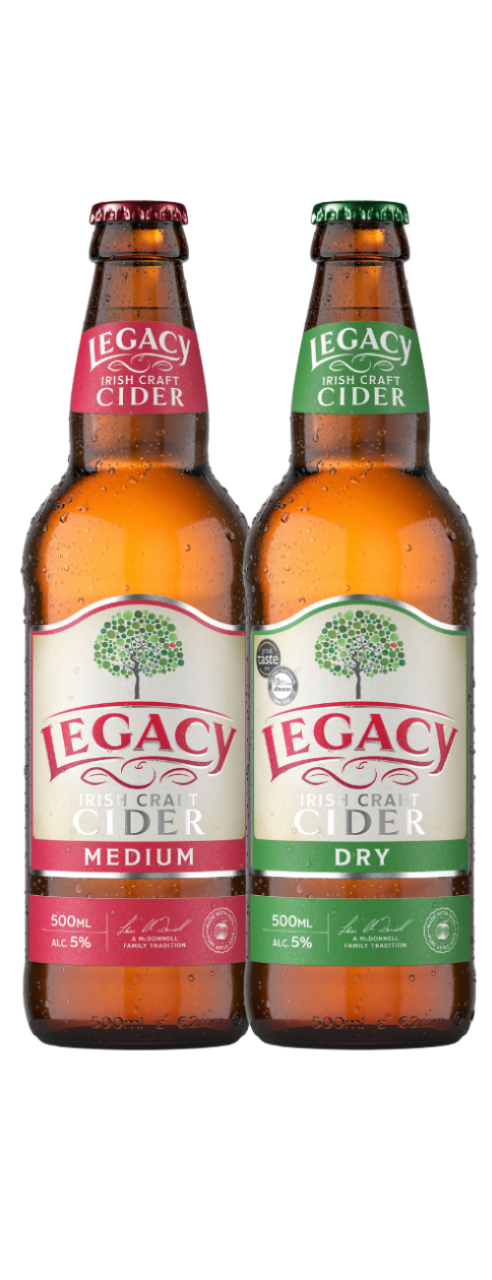




Legacy Irish Cider
PURE & NATURAL IRISH CIDER
When a Local Cider maker decided to put three Generations of heritage and history into a cider; Legacy Irish Cider was born.
Legacy Irish Cider is a range of natural crisp ciders fermented using natural wild yeasts from local handpicked apples.
Our Medium Dry Cider is the Original Legacy Cider. It is a little dry and has a lovely balance between sweet and Dry. It starts off a little sweet, has a green apple sharp note and finished with a lingering dryness. A great cider with fish or white meat.
Our new addition to the Legacy Cider Family is our Medium Cider. This is a completely different cider; a ripe red apple sweetness, rich caramel notes, subtle tannins on the mid palate and a soft dry finish to balance. This is a cider drinker’s cider, a great thirst quencher! Easy drinking, great flavour profile and a natural apple aroma.
Our Ciders are naturally gluten free and vegan friendly.

Meet our Family
Legacy Irish Cider is three Generations in the making! My Grandfather was very enterprising. He planted apple orchards in West Waterford on the lush valley of the River Bride. My Dad became passionate in apple tree growing, achieved a PhD in the subject and developed his own miniature apple tree! I have been immersed in apples all my life, inspired to keep this tradition and privileged to produce my own cider.
We are a small passionate team enjoying the honesty of making a quality cider we can be proud of. We started off in 2015 in a garden shed, expanding to larger units and now we can be found in Dungarvan fermenting and maturing our quality cider in hefty steel tanks and wooden Vats! My Dad still keeps an eye on us ensuring we don’t step too far out of line and the business is on a solid footing.
Our Irish Ciders
LEGACY DRY
Our Medium Dry Cider is the first and the ‘Original Legacy Cider’. It’s my favouriteas I think it has a lovely balance between sweet and Dry. There is a “good bite to it” as I’ve been told often times, this “bite” is the strong Bramley flavour coming through.
The Medium Dry is made with only three apple varieties; Elstar, Bramley and Michellin. Elstar is a floral light cider that sits in the background, Bramley is the big bold mouthful and Michellin is a beautiful sweet French cider apple that gives a soft caramel flavour and a lingering dryness.

LEGACY MEDIUM
Our New Blend is our most recent addition and now on the shelves of all good off licences and bars!
I’ve really enjoyed blending this ‘Medium’ cider. I’ve combined natural and technical skills together to produce this beautiful new blend.We’ve been working on this idea over the last nine months trialling young ciders with more mature ciders and adding a few new apple varieties into the mix. In the end we had 4 different blends that made it to the final stages and the one that won hands down? Yes, it’s on the shelves!

News Feed
Irish Cider- A Brief History
Cider making in Ireland
For various historical reasons it is thought that cidermaking in Ireland stretches back at least 2000 years if not much further. The religious orders and monasteries would have been instrumental in the production of cider just as they were with the brewing of beer, bee keeping, river fisheries and animal and crop husbandry within the vast tracts of farmland they controlled. The ancient texts are so far somewhat silent on the matter of cidermaking, although the first definite mention appears in the 12th century when a tribal leader from Ulster is praised for the cider he made from the produce of his orchards.

We have to wait until the early modern period and the 17th,18th, and 19th centuries before the discussion of cidermaking in Ireland becomes commonplace among writers of the time. The Civil Surveys of the 1650s contain numerous entries regarding orchards and cidermaking and it seems that farmhouse cidermaking was well established in Ireland by this time, this was further bolstered by the Plantations and also the settlement of the Huguenots from France and the Palatines from Germany. It appears the heyday of Irish farmhouse cidermaking was during the 18th century and the opening decades of the 19th century, with writers both here and abroad commenting on the excellent qualities of Irish ciders. An example of this quality can be found in a late 18th century commentary about a cider competition held in Dublin where the judges refused to give the premier award to one of the entrants until it could be proven that no fine white wines had been used in its making as the quality was considered so superior.
Contrary to popular belief, cidermaking was not confined to the traditional apple growing regions of Ireland we are familiar with today such as Armagh (the orchard county), Dublin, Tipperary, Waterford and Kilkenny, as records exist of cidermaking from at least ten other counties all across Ireland. As with many things in Ireland the famine years almost wiped out cidermaking and it was not until later in the 19th century and the early 1900s that a revival occurred. In the apple growing regions the then equivalent of the department of agriculture employed instructors skilled in cidermaking to visit farms and advise on all aspects of cidermaking and at the same time apple crushing machines and presses travelled to the farms during harvest to process the apples and many farmers developed their own labels and brands for their ciders. By the mid 1940s after two world wars and our own civil war, farmhouse cidermaking was once again in decline and the few remaining crushers and presses no longer travelled but were in fixed locations and farmers had to transport their crop to them for processing which meant it was no longer an attractive proposition for many.Learn more at www.ciderireland.com

